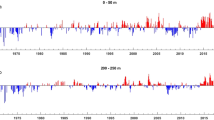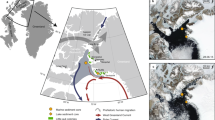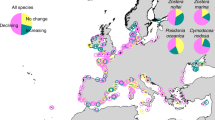Abstract
The highly productive northern Bering and Chukchi marine shelf ecosystem has long been dominated by strong seasonality in sea-ice and water temperatures. Extremely warm conditions from 2017 into 2019—including loss of ice cover across portions of the region in all three winters—were a marked change even from other recent warm years. Biological indicators suggest that this change of state could alter ecosystem structure and function. Here, we report observations of key physical drivers, biological responses and consequences for humans, including subsistence hunting, commercial fishing and industrial shipping. We consider whether observed state changes are indicative of future norms, whether an ecosystem transformation is already underway and, if so, whether shifts are synchronously functional and system wide or reveal a slower cascade of changes from the physical environment through the food web to human society. Understanding of this observed process of ecosystem reorganization may shed light on transformations occurring elsewhere.
This is a preview of subscription content, access via your institution
Access options
Access Nature and 54 other Nature Portfolio journals
Get Nature+, our best-value online-access subscription
$29.99 / 30 days
cancel any time
Subscribe to this journal
Receive 12 print issues and online access
$209.00 per year
only $17.42 per issue
Buy this article
- Purchase on Springer Link
- Instant access to full article PDF
Prices may be subject to local taxes which are calculated during checkout





Similar content being viewed by others
Data availability
All data collected as a part of the North Pacific Research Board’s Arctic Integrated Ecosystem Research Program (Arctic IERP) are being curated and preserved. As the research is actively ongoing, the data are under program embargo until July 2021. At that time, all Arctic IERP data will be publicly released with a CC-0 license from the Research Workspace DataONE Member Node, and this paper will be cited in the doi for those data. In the interim, please contact the authors for access to Arctic IERP data.
In Fig. 1, we acknowledge the use of imagery from the NASA Worldview application (https://worldview.earthdata.nasa.gov/), part of the NASA Earth Observing System Data and Information System (EOSDIS). Ice-edge marking is from ref. 51.
2015 epifauna data are available at https://doi.org/10.25921/b2g4-bs86.
Other data are available on request, pending curation and archiving as part of ongoing studies.
References
Grebmeier, J. M., Cooper, L. W., Feder, H. W. & Sirenko, B. I. Ecosystem dynamics of the Pacific-influenced northern Bering and Chukchi seas in the Amerasian Arctic. Prog. Oceanogr. 71, 331–361 (2006).
Woodgate, R. A. Increases in the pacific inflow to the Arctic from 1990 to 2015, and insights into seasonal trends and driving mechanisms from year-round Bering Strait mooring data. Prog. Oceanogr. 160, 124–154 (2018).
Codispoti, L. A. et al. Synthesis of primary production in the arctic ocean. III. Nitrate and phosphate based estimates of net community production. Prog. Oceanogr. 110, 126–150 (2013).
Kuletz, K. et al. Seasonal spatial patterns in seabird and marine mammal distribution in the eastern Chukchi and western Beaufort seas: identifying biologically important pelagic areas. Prog. Oceanogr. 136, 175–200 (2015).
Cooper, L. W. et al. The relationship between sea ice break-up, water mass variation, chlorophyll biomass, and sedimentation in the northern Bering Sea. Deep Sea Res. II 65–70, 141–162 (2012).
Smith, M. A., Goldman, M. S., Knight, E. J. & Warrenchuk, J. Ecological Atlas of the Bering, Chukchi, and Beaufort Seas 2nd edn (Audubon Alaska, 2018).
Grebmeier, J. M. et al. Ecosystem characteristics and processes facilitating persistent macrobenthic biomass hotspots and associated benthivory in the Pacific Arctic. Prog. Oceanogr. 136, 92–114 (2015).
Moore, S. E., Stabeno, P. J., Grebmeier, J. M. & Okkonen, S. R. The Arctic marine pulses model: linking annual oceanographic processes to contiguous ecological domains in the pacific arctic. Deep Sea Res. II 152, 8–21 (2018).
Stabeno, P. J. et al. Comparison of warm and cold years on the southeastern bering sea shelf and some implications for the ecosystem. Deep Sea Res. II 65, 31–45 (2012).
Sigler, M. et al. Fluxes, fins, and feathers: relationships among the bering, chukchi, and beaufort seas in a time of climate change. Oceanography 24, 250–265 (2011).
Haynie, A. C. & Pfeiffer, L. Climatic and economic drivers of the bering sea walleye pollock (Theragra chalcogramma) fishery: implications for the future. Can. J. Fish. Aquat. Sci. 70, 841–853 (2013).
Stroeve, J. C. et al. The Arctic’s rapidly shrinking sea ice cover: a research synthesis. Clim. Change 110, 1005–1027 (2012).
Hunt, G. L. Jr et al. Advection in polar and sub-polar environments: impacts on high latitude marine ecosystems. Prog. Oceanogr. 149, 40–81 (2016).
Dunmall, K. M., et al. in Responses of Arctic Marine Ecosystems to Climate Change (eds Mueter, F. J. et al.) 141–163 (Alaska Sea Grant, University of Alaska Fairbanks, 2013); https://doi.org/10.4027/ramecc.2013.07
Moore, S. E., et al. in The Pacific Arctic Region: Ecosystem Status and Trends in a Rapidly Changing Environment (eds J. M. Grebmeier, J. M. & Maslowski, W.) 337–392 (Springer, 2014); https://doi.org/10.1007/978-94-017-8863-2_2
Jay, C. V., Taylor, R. L., Fischbach, A. S., Udevitz, M. S. & Beatty, W. S. Walrus haul-out and in water activity levels relative to sea ice availability in the Chukchi Sea. J. Mammal. 98, 386–396 (2017).
Stafford, K. M. Increasing detections of killer whales (Orcinus orca), in the Pacific Arctic. Mar. Mammal. Sci. 67, 696–706 (2018).
Gall, A. E., Morgan, T. C., Day, R. H. & Kuletz, K. J. Ecological shift from piscivorous to planktivorous seabirds in the Chukchi Sea, 1975-2012. Polar Biol. 40, 61–78 (2017).
Renner, M. et al. Modeled distribution and abundance of a pelagic seabird reveal trends in relation to fisheries. Mar. Ecol. Prog. Ser. 484, 259–277 (2013).
Kuletz, K. J., Renner, M., Labunski, E. A. & Hunt, G. L. Changes in the distribution and abundance of albatrosses in the eastern Bering Sea: 1975–2010. Deep Sea Res. II 109, 282–292 (2014).
Huntington, H. P., Quakenbush, L. T. & Nelson, M. Evaluating the effects of climate change on indigenous marine mammal hunting in northern and western alaska using traditional knowledge. Front. Mar. Sci. 4, 319 (2017).
Noongwook, G., the Native Village of Gambell, the Native Village of Savoonga, H.P., Huntington, H. P. & George, J. C. Traditional knowledge of the bowhead whale (Balaena mysticetus) around St. Lawrence Island, Alaska. Arctic 60, 47–54 (2007).
Stabeno, P. J. & Bell, S. W. Extreme conditions in the Bering Sea (2017-2018): record-breaking low sea-ice extent. Geophys. Res. Lett. 46, 8952–8959 (2019).
Duffy-Anderson, J. T. et al. Response of the northern bering sea and southeastern bering sea pelagic ecosystems following record-breaking low winter sea ice. Geophys. Res. Lett. 46, 9333–9842 (2019).
Lefebvre, K. A. et al. Prevalence of algal toxins in Alaskan marine mammals foraging in a changing Arctic and subarctic environment. Harmful Algae 55, 13–24 (2016).
Brenner, R. E., Munro, A. R. & Larsen, S. J. (eds.) Run Forecasts and Harvest Projections for 2019 Alaska Salmon Fisheries and Review of the 2018 Season Special Publication no. 19-07 (Alaska Department of Fish and Game, 2019).
Stevenson, D. E. & Lauth, R. R. Bottom trawl surveys in the northern Bering Sea indicate recent shifts in the distribution of marine species. Polar Biol. 42, 407–421 (2019).
Siddon, E. & Zador, S. Ecosystem Considerations 2017: Status of the Eastern Bering Sea Marine Ecosystem (Alaska Fisheries Science Center, National Marine Fisheries Service, NOAA, 2017); www.afsc.noaa.gov/REFM/Docs/2017/ecosysEBS.pdf
Dragoo, D. E., Renner, H. M. & Kaler, R. S. A. Breeding Status and Population Trends of Seabirds in Alaska, 2018 Report AMNWR 2019/03 (US Fish and Wildlife Service, 2019).
Quakenbush, L. T. & Citta, J. J. Satellite Tracking of Bowhead Whales: Habitat Use, Passive Acoustic, and Environmental Monitoring (US Department of the Interior, 2019).
2018–2019 Ice Seal Unusual Mortality Event in Alaska (National Oceanic and Atmospheric Administration, 2019); https://www.fisheries.noaa.gov/alaska/marine-life-distress/2018-2019-ice-seal-unusual-mortality-event-alaska
Heintz, R. A., Siddon, E. C., Farley, E. V. & Napp, J. M. Correlation between recruitment and fall condition of age‐0 pollock (Theragra chalcogramma) from the eastern bering sea under varying climate conditions. Deep Sea Res. II 94, 150–156 (2013).
Wassman, P. & Lenton, T. M. Arctic tipping points in an earth system perspective. Ambio 41, 1–9 (2012).
Lynam, C. P. et al. Trophic and environmental control in the North Sea. Proc. Natl Acad Sci. USA 114, 1952–1957 (2017).
Grebmeier, J. M. et al. Time-series benthic community composition and biomass and associated environmental characteristics in the Chukchi Sea during the RUSALCA 2004–2012 program. Oceanography 28, 116–133 (2015).
Iken, K. et al. Developing an observational design for epibenthos and fish assemblages in the Chukchi Sea. Deep Sea Res. II 162, 180–190 (2019).
Scheffer, M. et al. Anticipating critical transitions. Science 338, 344–348 (2012).
Overpeck, J. T. et al. Arctic system on trajectory to new state. Eos 86, 309–313 (2005).
Gunderson, L. & Holling, C. S. Panarchy: Understanding Transformations in Human and Natural Systems (Island, 2001).
IPCC. Climate Change 2014: Synthesis Report. Contribution of Working Groups I, II and III to the Fifth Assessment Report of the Intergovernmental Panel on Climate Change (IPCC, 2014).
Huntington, H. P. et al. in Ocean Sustainability in the 21st Century (ed. Arico, S.) 109–126 (Cambridge University Press, 2015).
Huntington, H. P. et al. How small communities respond to environmental change: patterns from tropical to polar ecosystems. Ecol. Soc. 22, 9 (2017).
Huntington, H. P. et al. Vessels, risks, and rules: planning for safe shipping in Bering Strait. Mar. Policy 51, 119–127 (2015).
Alaskan Inuit Food Security Conceptual Framework: How to Assess the Arctic from an Inuit Perspective Technical Report (Inuit Circumpolar Council-Alaska, 2015).
Huggett, A. J. The concept and utility of ecological thresholds in biodiversity conservation. Biol. Conserv. 124, 301–310 (2005).
Hunt, G. L. et al. Climate change and control of the southeastern Bering Sea pelagic ecosystem. Deep Sea Res. II 49, 5821–5853 (2002).
Rocha, J., Yletyinen, J., Biggs, R., Blenckner, T. & Peterson Marine regime shifts: drivers and impacts on ecosystems services. Philos. Trans. R. Soc. B 370, 20130273 (2015).
Konar, B., Frisch, L. & Moran, S. B. Development of best practices for scientific research vessel operations in a changing arctic: a case study for R/V Sikuliaq. Mar. Policy 86, 182–189 (2017).
Rocha, J. C., Peterson, G. D. & Biggs, R. Regime shifts in the anthropocene: drivers, risks, and resilience. PLoS ONE 10, e0134639 (2015).
De Robertis, A., Taylor, K., Wilson, C. & Farley, E. Abundance and distribution of arctic cod (Boreogadus saida) and other pelagic fishes over the U.S. continental shelf of the northern Bering and Chukchi seas. Deep Sea Res. II 135, 51–65 (2017).
Maslanik, J. & Stroeve, J. Near-Real-Time DMSP SSMIS Daily Polar Gridded Sea Ice Concentrations, Version 1 (National Snow and Ice Data Center, accessed 12 December 2018).
Acknowledgements
Much of the research reported here and preparation of the manuscript was conducted under the Arctic Integrated Ecosystem Research Program (Arctic IERP; http://www.nprb.org/arctic-program/). This manuscript is Publication Arctic IERP-014. Funding for the programme was provided by North Pacific Research Board, the US Bureau of Ocean Energy Management, the Collaborative Alaskan Arctic Studies Program (formerly the North Slope Borough/Shell Baseline Studies Program) and the US Office of Naval Research Marine Mammals and Biology Program. Generous support was provided by the US National Oceanic and Atmospheric Administration (NOAA; Alaska Fisheries Science Center and Pacific Marine Environmental Laboratory), University of Alaska Fairbanks, US Fish and Wildlife Service, and the US National Science Foundation. The findings and conclusions of this paper are those of the authors and not necessarily those of the agencies and organizations with which the authors are affiliated or which provided support. This manuscript is a contribution to the US Marine Biodiversity Observation Network (MBON), the US Integrated Ocean Observing System and the Group on Earth Observations Biodiversity Observation Network (GEO BON). The work and publication were partially funded under the US National Oceanographic Partnership Program (NOPP) through NOAA award no. UAF NA14NOS0120158 Arctic Marine Biodiversity Observing Network (AMBON), with contributions from the NOAA, US Bureau of Ocean Management (BOEM) and Shell Exploration and Production under management of the Integrated Ocean Observing System (IOOS), as well as contributions of US National Science Foundation (NSF) grant no. 1204082. We are grateful for the contributions of many colleagues to the research and writing of this paper, including Gay Sheffield. This paper is PMEL contribution no. 4917. Collections of fish specimens were made under the auspices and terms of Scientific Research Permit numbers 2012-11, 2013-8, 2017-2 and 2019-7 issued by the NOAA’s Alaska Regional Office and permit numbers CF-12-005, CF-13-016, CF-17-023 and CF-19-018 from Alaska’s Department of Fish and Game. C.W. is now retired.
Author information
Authors and Affiliations
Contributions
H.P.H., S.L.D., F.K.W., E.F., C.L. and K.S. developed the idea and contributed to writing and editing the paper. M.B., P.B., J.J.C., A.D.R., D.M.S.D., J.C.G., K.I., D.G.K., K.K., R.L., L.Q., P.S., D.S. and C.W. wrote sections of the paper and contributed to editing of the manuscript. All authors provided data and reviewed the final manuscript and approved it for submission and publication.
Corresponding author
Ethics declarations
Competing interests
The authors declare no competing interests.
Additional information
Peer review information Nature Climate Change thanks Gerald Darnis, Sang Lee and the other, anonymous, reviewer(s) for their contribution to the peer review of this work.
Publisher’s note Springer Nature remains neutral with regard to jurisdictional claims in published maps and institutional affiliations.
Supplementary information
Source data
Source Data Fig. 2
Spreadsheets of temperature measurements at two sites.
Source Data Fig. 3
Spreadsheet of toxin levels in samples at various sites.
Source Data Fig. 4
Spreadsheets of sample data for pink salmon, zooplankton, and epibenthos at various sites.
Rights and permissions
About this article
Cite this article
Huntington, H.P., Danielson, S.L., Wiese, F.K. et al. Evidence suggests potential transformation of the Pacific Arctic ecosystem is underway. Nat. Clim. Chang. 10, 342–348 (2020). https://doi.org/10.1038/s41558-020-0695-2
Received:
Accepted:
Published:
Issue Date:
DOI: https://doi.org/10.1038/s41558-020-0695-2
This article is cited by
-
Estimation of pop-up satellite archival tag initial surface position: applications for eastern Bering Sea crab research
Animal Biotelemetry (2024)
-
Do beluga whales truly migrate? Testing a key trait of the classical migration syndrome
Movement Ecology (2023)
-
Occurrence and patterns of fin whale songs reveal alternative migration strategies in Svalbard Islands, Norway
Scientific Reports (2023)
-
Temporal dynamics and environmental drivers of polar cod (Boreogadus saida) densities in the northeast Chukchi Sea
Polar Biology (2023)
-
Global gateways as telecoupled human and natural systems: The emerging case of the Bering Strait
Ambio (2023)



